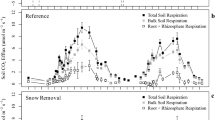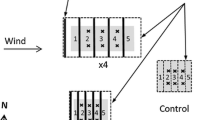Abstract
Background and aims
An advance in snowmelt timing in seasonally snow covered ecosystems has a wide range of potential impacts on plant and soil processes. Plants may respond to earlier melt through changes in phenology and altered allocation of resources to growth and reproduction, and earlier snowmelt may impact active pools of soil C such as microbial biomass and dissolved organic C (DOC).
Methods
In subalpine aspen forests and open meadows in the Wasatch Plateau of the western Rocky Mountains, we manipulated snowmelt timing by adding dust to the snow surface. We obtained a treatment-induced snow-free interval of 6 to 22 days (3% to 11% reduction in snow-covered days). We observed the growth of early and mid-season herbaceous species, measuring above ground biomass, flower and seed counts, and seed mass. We also monitored microbial biomass, DOC, and soil respiration in the days and weeks following snowmelt.
Results
We observed generally warmer soil temperatures in the early snowmelt plots compared to controls. However, we found no difference in microbial biomass C or DOC following snowmelt and we found no legacy effect in growing season soil respiration as a result of earlier snowmelt. After three years of repeated treatments, total soil organic C remained unchanged between treatment and control plots.
Conclusions
Although earlier snowmelt is likely to have a variety of impacts on subalpine ecosystems, we found no change in plant biomass or reproductive allocation and we found that carbon pools and fluxes were not perturbed by earlier snowmelt. A common expectation is that earlier snowmelt will lead to more frequent freeze-thaw cycles in soils, and studies have shown that freeze-thaw events can have significant but temporary impacts on soil C efflux. This study indicates that subalpine plants and soils may be at least partially buffered from some of the anticipated effects of earlier snowmelt. One direction of continuing research may be to identify adaptive buffers in subalpine ecosystems, an understanding of which may be useful in anticipating and responding to future climate change.



Similar content being viewed by others
References
Aanderud ZT, Jones SE, Schoolmaster DR Jr, Fierer N, Lennon JT (2013) Sensitivity of soil respiration and microbial communities to altered snowfall. Soil Biol Biochem 57:217–227
Bates D, Maechler M, Bolker B, Walker S (2014) lme4: Linear mixed-effects models using Eigen and S4. R package version 1.7
Blankinship JC, Hart SC (2012) Consequences of manipulated snow cover on soil gaseous emission and N retention in the growing season: a meta-analysis. Ecosphere 3:art1
Blankinship JC, Hart SC (2014) Hydrological control of greenhouse gas fluxes in a sierra Nevada subalpine meadow. Arct Antarct Alp Res 46:355–364
Bokhorst S, Metcalfe DB, Wardle DA (2013) Reduction in snow depth negatively affects decomposers but impact on decomposition rates is substrate dependent. Soil Biol Biochem 62:157–164
Brooks PD, Williams M, Schmidt S (1996) Microbial activity under alpine snowpacks, Niwot ridge, Colorado. Biogeochemistry 32:93–13
Brooks PD, Williams MW, Schmidt SK (1998) Inorganic nitrogen and microbial biomass dynamics before and during spring snowmelt. Biogeochemistry 43:1–15
Brooks PD, McKnight D, Elder K (2005) Carbon limitation of soil respiration under winter snowpacks: potential feedbacks between growing season and winter carbon fluxes. Glob Chang Biol 11:231–238
Buchmann N (2000) Biotic and abiotic factors controlling soil respiration rates in Picea abies stands. Soil Biol Biochem 32:1625–1635
Carbone MS, Still CJ, Ambrose AR, Dawson TE, Williams AP, Boot CM, Schaeffer SM, Schimel JP (2011) Seasonal and episodic moisture controls on plant and microbial contributions to soil respiration. Oecologia 167:265–278
Conner LG, Gill RA, Belnap J (2016) Soil moisture response to experimentally altered snowmelt timing is mediated by soil, vegetation, and regional climate patterns. Ecohydrology 9:1006–1016
Durán J, Morse JL, Groffman PM, Campbell JL, Christenson LM, Driscoll CT, Fahey TJ, Fisk MC, Mitchell MJ, Templer PH (2014) Winter climate change affects growing-season soil microbial biomass and activity in northern hardwood forests. Glob Chang Biol 20:3568–3577
Edwards AC, Scalenghe R, Freppaz M (2007) Changes in the seasonal snow cover of alpine regions and its effect on soil processes: a review. Quat Int 162–163:172–181
Ernakovich JG, Hopping KA, Berdanier AB, Simpson RT, Kachergis EJ, Steltzer H, Wallenstein MD (2014) Predicted responses of arctic and alpine ecosystems to altered seasonality under climate change. Glob Chang Biol 20:3256–3269
Fan ZS, Neff JC, Wickland KP (2010) Modeling the production, decomposition, and transport of dissolved organic carbon in boreal soils. Soil Sci 175:223–232
Fox J, Weisberg S (2011) An {R} companion to applied regression, 2nd edn. Sage, Thousand Oaks
Groffman P, Driscoll C, Fahey T, Hardy J, Fitzhugh R, Tierney G (2001) Colder soils in a warmer world: a snow manipulation study in a northern hardwood forest ecosystem. Biogeochemistry 56:135–150
Groffman P, Hardy J, Fashu-Kanu S, Driscoll C, Cleavitt N, Fahey T, Fisk M (2011) Snow depth, soil freezing and nitrogen cycling in a northern hardwood forest landscape. Biogeochemistry 102:223–238
Groisman PY, Davies TD (2001) Snow cover and the climate system. In: Jones HG, Pomeroy JW, Walker DA, Hoham RW (eds) Snow ecology: an interdisciplinary examination of snow-covered ecosystems. Cambridge University Press, Cambridge
Haei M, Rousk J, Ilstedt U, Öquist M, Bååth E, Laudon H (2011) Effects of soil frost on growth, composition and respiration of the soil microbial decomposer community. Soil Biol Biochem 43:2069–2077
Holm S (1979) A simple sequentially rejective multiple test procedure. Scand J Stat 6:65–70
Jefferies RL, Walker NA, Edwards KA, Dainty J (2010) Is the decline of soil microbial biomass in late winter coupled to changes in the physical state of cold soils? Soil Biol Biochem 42:129–135
Larsen K, Grogan P, Jonasson S, Michelsen A (2007) Respiration and microbial dynamics in two subarctic ecosystems during winter and spring thaw: effects of increased snow depth. Arct Antarct Alp Res 39:268–276
Lavigne MB, Foster RJ, Goodine G (2004) Seasonal and annual changes in soil respiration in relation to soil temperature, water potential and trenching. Tree Physiol 24:415–424
Lawrence CR, Neff JC, Schimel JP (2009) Does adding microbial mechanisms of decomposition improve soil organic matter models? A comparison of four models using data from a pulsed rewetting experiment. Soil Biol Biochem 41:1923–1934
Lawrence CR, Harden JW, Xu XM, Schulz MS, Trumbore SE (2015) Long-term controls on soil organic carbon with depth and time: a case study from the Cowlitz River Chronosequence, WA USA. Geoderma 247:73–87
Lipson DA, Schmidt SK, Monson RK (2000) Carbon availability and temperature control the post-snowmelt decline in alpine soil microbial biomass. Soil Biol Biochem 32:441–448
Matzner E, Borken W (2008) Do freeze-thaw events enhance C and N losses from soils of different ecosystems? A review. Eur J Soil Sci 59:274–284
Maurer GE, Bowling DR (2014a) Seasonal snowpack characteristics influence soil temperature and water content at multiple scales in interior western U.S. mountain ecosystems. Water Resour Res 50:5216–5234
Maurer GE, Bowling DR (2014b) Dust effects on snowpack melt and related ecosystem processes are secondary to those of forest canopy structure and interannual snowpack variability. Ecohydrology 8:1005–1023
McNamara JP, Chandler D, Seyfried M, Achet S (2005) Soil moisture states, lateral flow, and streamflow generation in a semi-arid, snowmelt-driven catchment. Hydrol Process 19:4023–4038
Miller AE, Schimel JP, Sickman JO, Meixner T, Doyle AP, Melack JM (2007) Mineralization responses at near-zero temperatures in three alpine soils. Biogeochemistry 84:233–245
Miller AE, Schimel JP, Sickman JO, Skeen K, Meixner T, Melack JM (2009) Seasonal variation in nitrogen uptake and turnover in two high-elevation soils: mineralization responses are site-dependent. Biogeochemistry 93:253–270
Neff JC, Asner GP (2001) Dissolved organic carbon in terrestrial ecosystems: synthesis and a model. Ecosystems 4:29–48
Neff JC, Ballantyne AP, Farmer GL, Mahowald NM, Conroy JL, Landry CC, Overpeck JT, Painter TH, Lawrence CR, Reynolds RL (2008) Increasing eolian dust deposition in the western United States linked to human activity. Nat Geosci 1:189–195
ÖQuist MG, Laudon H (2008) Winter soil frost conditions in boreal forests control growing season soil CO2 concentration and its atmospheric exchange. Glob Chang Biol 14:2839–2847
Painter TH, Barrett AP, Landry CC, Neff JC, Cassidy MP, Lawrence CR, McBride KE, Farmer GL (2007) Impact of disturbed desert soils on duration of mountain snow cover. Geophys Res Lett 34:L12502
Parton WJ, Schimel DS, Cole CV, Ojima DS (1987) Analysis of factors controlling soil organic-matter levels in great plains grasslands. Soil Sci Soc Am J 51:1173–1179
Pederson GT, Gray ST, Ault T, Marsh W, Fagre DB, Bunn AG, Woodhouse CA, Graumlich LJ (2010) Climatic controls on the snowmelt hydrology of the northern Rocky Mountains. J Clim 24:1666–1687
Puissant J, Cecillon L, Mills RTE, Robroek BJM, Gavazov K, De Danieli S, Spiegelberger T, Buttler A, Brun JJ (2015) Seasonal influence of climate manipulation on microbial community structure and function in mountain soils. Soil Biol Biochem 80:296–305
R Core Development Team (2014) R: a language and environment for statistical computing. R Foundation for Statistical Computing, Vienna, Austria
Raich JW, Potter CS, Bhagawati D (2002) Interannual variability in global soil respiration, 1980–94. Glob Chang Biol 8:800–812
Reichstein M, Subke JA, Angeli JA, Tenhunen JD (2005) Does the temperature sensitivity of decomposition of soil organic matter depend upon water content, soil horizon, or incubation time? Glob Chang Biol 11:1754–1767
Schimel JP, Schaeffer SM (2012) Microbial control over carbon cycling in soil. Frontiers in Microbiology 3:art348. doi:10.3389/fmicb.2012.00348.
Schimel JP, Balser TC, Wallenstein M (2007) Microbial stress-respononse physiology and its implications for ecosystem function. Ecology 88:1386–1394
Scott-Denton LE, Rosenstiel TN, Monson RK (2006) Differential controls by climate and substrate over the heterotrophic and rhizospheric components of soil respiration. Glob Chang Biol 12:205–216
Symonds ME, Moussalli A (2011) A brief guide to model selection, multimodel inference and model averaging in behavioural ecology using Akaike’s information criterion. Behav Ecol Sociobiol 65:13–21
Wang C, Han Y, Chen J, Wang X, Zhang Q, Bond-Lamberty B (2013) Seasonality of soil CO2 efflux in a temperate forest: biophysical effects of snowpack and spring freeze–thaw cycles. Agric For Meteorol 177:83–92
Warren CR, Taranto MT (2011) Ecosystem respiration in a seasonally snow-covered subalpine grassland. Arct Antarct Alp Res 43:137–146
Zak DR, Groffman PM, Pregitzer KS, Christensen S, Tiedje JM (1990) The vernal dam: plant-microbe competition for nitrogen in northern hardwood forests. Ecol Evol 71:651–656
Acknowledgements
The authors wish to thank Michael McQueen, Desiree Lindley, and MacKenzie Mayo for help collecting data and analyzing soil samples, Rachel Buck and the BYU Environmental Analytics lab for consultation and use of instruments, Debbie Rigby and Zach Anderud for help with analysis methods, and Jayne Belnap, David Bowling, Samuel St. Clair, and Roger Koide for consultation on the design of the snow manipulation experiment. We would like to thank Jeff Gardiner (BLM) for help locating the dust source and for permission to collect dust and the Manti-La Sal National Forest for permission to conduct research in Fairview Canyon. Funding for this research was provided by the GA Harris Graduate Research Instrumentation Fellowship (Decagon Devices, Inc.), Brigham Young University Graduate Studies Research Fellowship, Brigham Young University Mentoring Environment Grants, NASA Rocky Mountain Space Grant Consortium Graduate Research Fellowship, and the Charles Redd Center for Western Studies Summer Research Fellowship.
Author information
Authors and Affiliations
Corresponding author
Additional information
Responsible Editor: Zucong Cai.
Rights and permissions
About this article
Cite this article
Conner, L.G., Gill, R.A. & Harvey, J.T. Earlier snowmelt accompanied by warmer soil temperatures in mid-latitude aspen forest and subalpine meadow: Implications for soil carbon. Plant Soil 417, 275–285 (2017). https://doi.org/10.1007/s11104-017-3258-1
Received:
Accepted:
Published:
Issue Date:
DOI: https://doi.org/10.1007/s11104-017-3258-1




